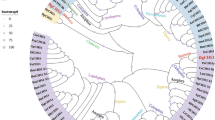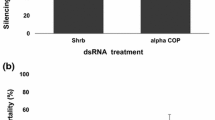Abstract
Grapholita molesta, a worldwide fruit-boring pest, is difficult to be effectively controlled due to the larvae feeding habit inside fruits. Neuropeptide F (NPF) is the crucial molecule modulating feeding behavior of insects. Herein, two genes, NPF1 and NPF2, were identified and cloned from G. molesta. GmolNPF1 had a higher expression in newly hatched larvae than in other developmental stages and mainly in the midgut (major expressive organ). Coincidentally, the stage of newly hatched larvae was the best control period to prevent larvae from entering the fruits. Further study demonstrated that only GmolNPF1 expression increased significantly after starvation and declined after refeeding. After GmolNPF1 knockdown by RNA interference (RNAi), the feeding amount, weight, body size and drill holes rate of larvae decreased significantly, and the number of larvae that ate food within 5 min declined significantly. The pET30-NPF1-BL21(DE3) RNase III system was successful constructed and produced large batch dsRNA (double stranded, ds) of GmolNPF1. The nanocarrier-mediated transdermal dsRNA delivery system enhanced the RNAi efficiency of dsNPF1, significantly decreased the fruit damage and increased the mortality of newly hatched larvae via spraying method. Our research not only revealed the regulation function of GmolNPF1 involved in the feeding behavior of G. molesta, but also showed the NPF1 as a molecular target combined the transdermal dsRNA delivery system will a potential control strategy for pest management in the field.






Similar content being viewed by others
References
Athanassiou CG, Kavallieratos NG, Benelli G, Losic D, Rani PU, Desneux N (2018) Nanoparticles for pest control: current status and future perspectives. J Pest Sci 91:1–15. https://doi.org/10.1007/s10340-017-0898-0
Bernhard W, Haagsman HP, Tschernig T, Poets CF, Postle AD, Van Eijk ME, Von der Hardt H (1997) Conductive airway surfactant: surface-tension function, biochemical composition, and possible alveolar origin. Am J Respir Cell Mol Biol 17:41–50. https://doi.org/10.1165/ajrcmb.17.1.2594
Brown MR, Crim JW, Arata RC, Cai HN, Chun C, Shen P (1999) Identification of a Drosophila brain-gut peptide related to the neuropeptide Y family. Peptides 20:1035–1042. https://doi.org/10.1016/S0196-9781(99)00097-2
Cai Q, He B, Kogel KH, Jin HL (2018) Cross-kingdom RNA trafficking and environmental RNAi—Natures blueprint for modern crop protection strategies. Curr Opin Microbiol 46:58–64. https://doi.org/10.1016/j.mib.2018.02.003
Cao JJ, Liu YC, Yang YH, Zhang HJ, Li Z, Yang QP, Zhang SD, Zhang QW, Liu XX (2015) Molecular characterization and functional analysis of the ultraspiracle (USP) in the oriental fruit moth Grapholita molesta (Lepidoptera: Olethreutidae). Comp Biochem Physiol B Biochem Mol Biol 190:54–62. https://doi.org/10.1016/j.cbpb.2015.08.008
Chubb B, Whitehouse C, Judd G, Evenden M (2012) Success of Grapholita molesta (Busck) reared on the diet used for Cydia pomonella L. (Lepidoptera: Tortricidae) sterile insect release. J Entomol Soc Brit Columbia 109:48–54
Chung BY, Ro J, Hutter SA, Miller KM, Guduguntla LS, Kondo S, Pletcher SD (2017) Drosophila neuropeptide F signaling independently regulates feeding and sleep-wake behavior. Cell Rep 19:2441–2450. https://doi.org/10.1016/j.celrep.2017.05.085
Cunningham CB, Vandenheuvel K, Khana DB, McKinney EC, Moore AJ (2016) The role of neuropeptide F in a transition to parental care. Biol Lett 12:20160158. https://doi.org/10.1098/rsbl.2016.0158
Dierick HA, Greenspan RJ (2007) Serotonin and neuropeptide F have opposite modulatory effects on fly aggression. Nat Genet 39(5):678–682. https://doi.org/10.1038/ng2029
Fan RJ, Liu ZF, Lu JJ, Feng YT, Yu Q, Gao Y, Zhang RX (2013) Progress in the application of IPM to control the oriental fruit moth (Grapholitha molesta) in China. Chin J Appl Entomol 50(6):1509–1513. https://doi.org/10.7679/j.issn.2095-1353.2013.207
Ganbaatar O, Cao B, Zhang Y, Bao D, Bao W, Wuriyanghan H (2017) Knockdown of Mythimna separate chitinase genes via bacterial expression and oral delivery of RNAi effectors. BMC Biotechnol 17:9. https://doi.org/10.1186/s12896-017-0328-7
Gao Y, Zhang PJ, Zhao JY, Shi GC, Liu ZF, Zhang H, Fan RJ (2017) Effectiveness of five insecticides for controlling Carposina niponensis walsingham (Lepidoptera: carposinidae) and Grapholitha molesta Busck (Lepidoptera: tortricidae). Chin J Appl Entomol 54(6):1044–1051. https://doi.org/10.7679/j.issn.2095-1353.2017.124
He B, Chu Y, Yin MZ, Müllen K, An CJ, Shen J (2013) Fluorescent nanoparticle delivered dsRNA toward genetic control of insect pests. Adv Mater 25(33):4580–4584. https://doi.org/10.1002/adma.201301201
Hermann C, Yoshii T, DusikV H-F (2012) Neuropeptide F immunoreactive clock neurons modify evening locomotor activity and free-running period in Drosophila melanogaster. J Comp Neurol 520(5):970–987. https://doi.org/10.1002/cne.22742
Hu SR, Guan RB, Li HC, Miao XX (2019) Application of RNAi in insect pest management: important progress and problem. Acta Entomol Sinica 62(4):118–127. https://doi.org/10.16380/j.kcxb.2019.04.012
Huang Y, Crim JW, Nuss AB, Brown MR (2011) Neuropeptide F and the corn earworm, Helicoverpa zea: a midgut peptide revisited. Peptides 32(3):483–492. https://doi.org/10.1016/j.peptides.2010.09.014
Huang YC, Shi M, Cheng XX (2015) Advance in research on the insect neuropeptide F. Chin J Appl Entomol 52(6):1315–1325. https://doi.org/10.7679/j.issn.2095-1353.2015.157
Il’ichev AL, Williams DG, Milner AD (2004) Mating disruption barriers in pome fruit for improved control of oriental fruit moths, Grapholita molesta Busck (Lepidoptera: Tortricidae) in stone fruit under mating disruption. J Appl Entomol 128:126–132. https://doi.org/10.1111/j.1439-0418.2004.00822.x
Kim K, Jung CR, Yang CY, Kwon G, Kim Y (2017) Mating disruption of Grapholita molesta by RNA interference of a fatty acid desaturase expressed in adult abdomen. Korean J Appl Entomol 56:61–67. https://doi.org/10.5656/KSAE.2017.01.1.083
Kovanci OB, Walgenbach JF, Kennedy GG (2004) Evaluation of extended-season mating disruption of the Oriental fruit moth Grapholita molesta (Busck) (Lep. Tortricidae) in apples. J Appl Entomol 128(9–10):664–669. https://doi.org/10.1111/j.1439-0418.2004.00906.x
Krashes MJ, Das Gupta S, Vreede A, White B, Armstrong JD, Waddell S (2009) A neural circuit mechanism integrating motivational state with memory expression in Drosophila. Cell 139(2):416–427. https://doi.org/10.1016/j.cell.2009.08.035
Kunte N, McGraw E, Bell S, Held D, Avila L (2020) Prospects, challenges and current status of RNAi through insect feeding. Pest Manag Sci 76(1):26–41. https://doi.org/10.1002/ps.5588
Larkin MA, Blackshields G, Brown NP, Chenna R, Mcgettigan PA, Mcwilliam H, Valentin F, Wallace IM, Wilm A, Lopez R, Thompson JD, Gibson TG, Higgins DG (2007) Clustal W and Clustal X version 2.0. Bioinform 23(21):2947–2948. https://doi.org/10.1093/bioinformatics/btm404
Lee GH, Bahn JH, Park JH (2006) Sex- and clock-controlled expression of the neuropeptide F gene in Drosophila. Proc Natl Acad Sci 103(33):12580–12585. https://doi.org/10.1073/pnas.0601171103
Li X, Zhang M, Zhang H (2011) RNA interference of four genes in adult Bactrocera dorsalis by feeding their dsRNAs. PLoS ONE 6:e17788. https://doi.org/10.1371/journal.pone.0017788
Li X, Qu MJ, Zhang Y, Li JW, Liu TX (2018) Expression of neuropeptide F gene and its regulation of feeding behavior in the pea aphid Acyrthosiphon Pisum. Front Physiol 9:87. https://doi.org/10.3389/fphys.2018.00087
Li J, Qian J, Xu Y, Yan S, Shen J, Yin MZ (2019) A facile-synthesized star polycation constructed as a highly efficient gene vector in pest management. ACS Sustain Chem Eng 7(6):6316–6322. https://doi.org/10.1021/acssuschemeng.9b00004
Liu Y, Zhu F, Shen Z, Moural TW, Xu H (2021) Glutaredoxins and thioredoxin peroxidase involved in defense of emamectin benzoate induced oxidative stress in Grapholita molesta. Pestic Biochem Physiol 176:104881. https://doi.org/10.1016/j.pestbp.2021.104881
Liu WW, Ganguly A, Huang J, Wang YJ, Ni JD, Gurav AS, Aguilar MA, Montell C (2019) Neuropeptide F regulates courtship in Drosophila through a male-specific neuronal circuit. elife 8:e49574. https://doi.org/10.7554/eLife.49574
Livak KJ, Schmittgen TD (2001) Analysis of relative gene expression data using real-time quantitative PCR and the 2–ΔΔCt method. Methods 25(4):402–408. https://doi.org/10.1006/meth.2001.1262
Ma ZZ, Zhou H, Wei YL, Yan S, Shen J (2020) A novel plasmid-Escherichia coli system produces large batch dsRNAs for insect gene silencing. Pest Manag Sci 76(7):2505–2512. https://doi.org/10.1002/ps.5792
Mamta B, Rajam MV (2017) RNAi technology: a new platform for crop pest control. Physiol Mol Biol Plants 23(3):487–501. https://doi.org/10.1007/s12298-017-0443-x
Myers CT, Hull LA, Krawczyk G (2007) Effects of orchard host plants (apple and peach) on development of oriental fruit moth (Lepidoptera: Tortricidae). J Econ Entomol 100(2):421–430. https://doi.org/10.1093/jee/100.2.421
Ran HF, Lu ZY, Liu WX, Ma AH, Liu XX, Sun HP, Li JC, Zhang QW (2016) Advances in research on the biological control of the oriental fruit moth. Chin J Appl Entomol 53(5):931–941. https://doi.org/10.7679/j.issn.2095-1353.2016.116
Rauhut R, Jäger A, Conrad C, Klug G (1996) Identification and analysis of the rnc gene for RNase III in Rhodobacter capsulatus. Nucleic Acids Res 24:1246–1251. https://doi.org/10.1093/nar/24.7.1246
Sedra L, Lange AB (2016) Cloning and expression of long neuropeptide F and the role of FMRFamide-like peptides in regulating egg production in the Chagas vector, Rhodnius prolixus. Peptides 82:1–11. https://doi.org/10.1016/j.peptides.2016.05.003
Shen P, Cai HN (2001) Drosophila neuropeptide F mediates integration of chemosensory stimulation and conditioning of the nervous system by food. J Neurobiol 47:16–25. https://doi.org/10.1002/neu.1012
Shen D, Zhou F, Xu Z, He B, Li M, Shen J, Yin MZ, An CJ (2014) Systemically interfering with immune response by a fluorescent cationic dendrimer delivered gene suppression. J Mater Chem B 2(29):4653–4659. https://doi.org/10.1039/c4tb00411f
Tamura K, Stecher G, Peterson D, Filipski A, Kumar S (2013) MEGA6: molecular evolutionary genetics analysis version 6.0. Mol Biol Evol 30:2725–2729. https://doi.org/10.1093/molbev/mst197
Tan SQ, Li AM, Wang Y, Shi WP (2019) Role of the neuropeptide F 1 in regulating the appetite for food in Locusta migratoria. Pest Manag Sci 75:1304–1309. https://doi.org/10.1002/ps.5244
Timmons L, Fire A (1998) Specific interference by ingested dsRNA. Nature 395:854. https://doi.org/10.1038/27579
Veldhuizen EJA, Haagsman HP (2000) Role of pulmonary surfactant components in surface film formation and dynamics. Biochim Biophys Acta 1467:255–270. https://doi.org/10.1016/s0005-2736(00)00256-x
Wang YH, Ma ZS, Jia YY, Li HS (2013) Research advance in biological characteristics of oriental fruit moth (Grapholitha molesta). Acta Agriculturae Jiangxi 25(12):75–77. https://doi.org/10.19386/j.cnki.jxnyxb.2013.12.019
Wielendaele PV, Dillen S, Zels S, Badisco L, Broeck JV (2013) Regulation of feeding by Neuropeptide F in the desert locust Schistocerca Gregaria. Insect Biochem Mol Biol 43(1):102–114. https://doi.org/10.1016/j.ibmb.2012.10.002
Wu Q, Wen TQ, Lee G, Park JH, Cai HN, Shen P (2003) Developmental control of foraging and social behavior by the Drosophila neuropeptide Y-like system. Neuron 39(1):147–161. https://doi.org/10.1016/s0896-6273(03)00396-9
Xiong H, Liu X, Xu J, Zhang X, Cao S, Huang Q (2020) Safety assessment of a new benzoylphenylurea TXH09 and its efficacy against two borers Ostrinia furnacalis and Grapholitha molesta in field. Ecotox Environ Safe 197:110591. https://doi.org/10.1016/j.ecoenv.2020.110591
Xu J, Li M, Shen P (2010) A G-protein-coupled neuropeptide Y-like receptor suppresses behavioral and sensory response to multiple stressful stimuli in Drosophila. J Neurosci 30(7):2504–2512. https://doi.org/10.1523/JNEUROSCI.3262-09.2010
Yan S, Hu Q, Li JH, Chao ZJ, Cai C, Yin MZ, Du XG, Shen J (2019) A star polycation acts as a drug nanocarrier to improve the toxicity and persistence of botanical pesticides. ACS Sustain Chem Eng 7:17406–17413. https://doi.org/10.1021/acssuschemeng.9b04567
Yan S, Ren B, Zeng B, Shen J (2020a) Improving RNAi efficiency for pest control in crop species. Biotechniques. https://doi.org/10.2144/btn-2019-0171
Yan S, Qian J, Cai C, Ma ZZ, Li JH, Yin MZ, Ren B, Shen J (2020b) Spray method application of transdermal dsRNA delivery system for efficient gene silencing and pest control on soybean aphid Aphis glycines. J Pest Sci 93(1):449–459. https://doi.org/10.1007/s10340-019-01157-x
Yue Z, Liu XG, Zhou ZJ, Hua JP, Zhao ZW (2016) Development of a novel type transgenic cotton plant for control of cotton bollworm. Plant Biotechnol J 14:1747–1755. https://doi.org/10.1111/pbi.12534
Yue Z, Li XR, Zhang EY, Liu XX, Zhao ZW (2017) A potential and novel type transgenic corn plant for control of the Corn Borer. Sci Rep 7:44105. https://doi.org/10.1038/srep44105
Zheng Y, Hu YS, Yan S, Zhou H, Song DL, Yin MZ, Shen J (2019) A polymer/detergent formulation improves dsRNA penetration through the body wall and RNAi-induced mortality in the soybean aphid Aphis glycines. Pest Manag Sci 75:1993–1999. https://doi.org/10.1002/ps.5313
Zhu KY, Palli SR (2020) Mechanisms, applications, and challenges of insect RNA interference. Annu Rev Entomol 65(1):293–311. https://doi.org/10.1146/annurev-ento-011019-025224
Zhu F, Xu J, Palli R, Ferguson J, Palli SR (2011) Ingested RNA interference for managing the populations of the Colorado potato beetle, Leptinotarsa decemlineata. Pest Manag Sci 67:175–182. https://doi.org/10.1002/ps.2048
Acknowledgements
This work was supported by the China Agriculture Research System (grant number CARS-28).
Author information
Authors and Affiliations
Corresponding author
Ethics declarations
Conflict of interest
The authors declare that they have no conflict of interest.
Ethical approval
This article does not contain any studies with human participants or animals performed by any of the authors.
Additional information
Communicated by Subba Reddy Palli.
Publisher's Note
Springer Nature remains neutral with regard to jurisdictional claims in published maps and institutional affiliations.
Supplementary Information
Below is the link to the electronic supplementary material.
Rights and permissions
About this article
Cite this article
Wei, H., Tan, S., Yan, S. et al. Nanocarrier-mediated transdermal dsRNA-NPF1 delivery system contributes to pest control via inhibiting feeding behavior in Grapholita molesta. J Pest Sci 95, 983–995 (2022). https://doi.org/10.1007/s10340-021-01422-y
Received:
Revised:
Accepted:
Published:
Issue Date:
DOI: https://doi.org/10.1007/s10340-021-01422-y




